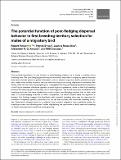Files in this item
The potential function of post-fledging dispersal behavior in first breeding territory selection for males of a migratory bird
Item metadata
| dc.contributor.author | Patchett, Robert | |
| dc.contributor.author | Styles, Patrick | |
| dc.contributor.author | Robins King, Joanna | |
| dc.contributor.author | Kirschel, Alexander N G | |
| dc.contributor.author | Cresswell, Will | |
| dc.date.accessioned | 2022-01-31T11:30:15Z | |
| dc.date.available | 2022-01-31T11:30:15Z | |
| dc.date.issued | 2022-12 | |
| dc.identifier | 277677952 | |
| dc.identifier | 54ebb5e3-bb62-4292-a7a3-a10a63889ae6 | |
| dc.identifier | 000925198600010 | |
| dc.identifier | 85140886363 | |
| dc.identifier.citation | Patchett , R , Styles , P , Robins King , J , Kirschel , A N G & Cresswell , W 2022 , ' The potential function of post-fledging dispersal behavior in first breeding territory selection for males of a migratory bird ' , Current Zoology , vol. 68 , no. 6 , zoac002 , pp. 708–715 . https://doi.org/10.1093/cz/zoac002 | en |
| dc.identifier.issn | 2396-9814 | |
| dc.identifier.other | Bibtex: 10.1093/cz/zoac002 | |
| dc.identifier.other | ORCID: /0000-0002-4684-7624/work/107718050 | |
| dc.identifier.uri | https://hdl.handle.net/10023/24779 | |
| dc.description | We thank the A.P. Leventis Conservation Foundation for supporting this work. | en |
| dc.description.abstract | One possible hypothesis for the function of post-fledging dispersal is to locate a suitable future breeding area. This post-fledging period may be particularly important in migratory species because they have a limited period to gather information prior to autumn migration, and in protandrous species, males must quickly acquire a territory after returning from spring migration to maximize their fitness. Here we use color-ring resightings to investigate how the post-fledging dispersal movements of the Cyprus wheatear Oenanthe cypriaca, a small migratory passerine, relate to their first breeding territory the following year when they return from migration. We found that males established first breeding territories that were significantly closer to their post-fledging location than to their natal sites or to post-fledging locations of other conspecifics, but these patterns were not apparent in females. Our findings suggest that familiarity with potential breeding sites may be important for juveniles of migratory species, particularly for the sex that acquires and advertises breeding territories. Exploratory dispersal prior to a migrant’s first autumn migration may contribute toward its breeding success the following year, further highlighting the importance of early seasonal breeding on fitness and population dynamics more generally. | |
| dc.format.extent | 8 | |
| dc.format.extent | 1032986 | |
| dc.language.iso | eng | |
| dc.relation.ispartof | Current Zoology | en |
| dc.subject | Dispersal | en |
| dc.subject | Migratory bird | en |
| dc.subject | Juvenile | en |
| dc.subject | Territory selection | en |
| dc.subject | QL Zoology | en |
| dc.subject | DAS | en |
| dc.subject | MCC | en |
| dc.subject.lcc | QL | en |
| dc.title | The potential function of post-fledging dispersal behavior in first breeding territory selection for males of a migratory bird | en |
| dc.type | Journal article | en |
| dc.contributor.institution | University of St Andrews. School of Biology | en |
| dc.contributor.institution | University of St Andrews. Centre for Biological Diversity | en |
| dc.contributor.institution | University of St Andrews. Scottish Oceans Institute | en |
| dc.contributor.institution | University of St Andrews. Institute of Behavioural and Neural Sciences | en |
| dc.identifier.doi | 10.1093/cz/zoac002 | |
| dc.description.status | Peer reviewed | en |
This item appears in the following Collection(s)
Items in the St Andrews Research Repository are protected by copyright, with all rights reserved, unless otherwise indicated.

